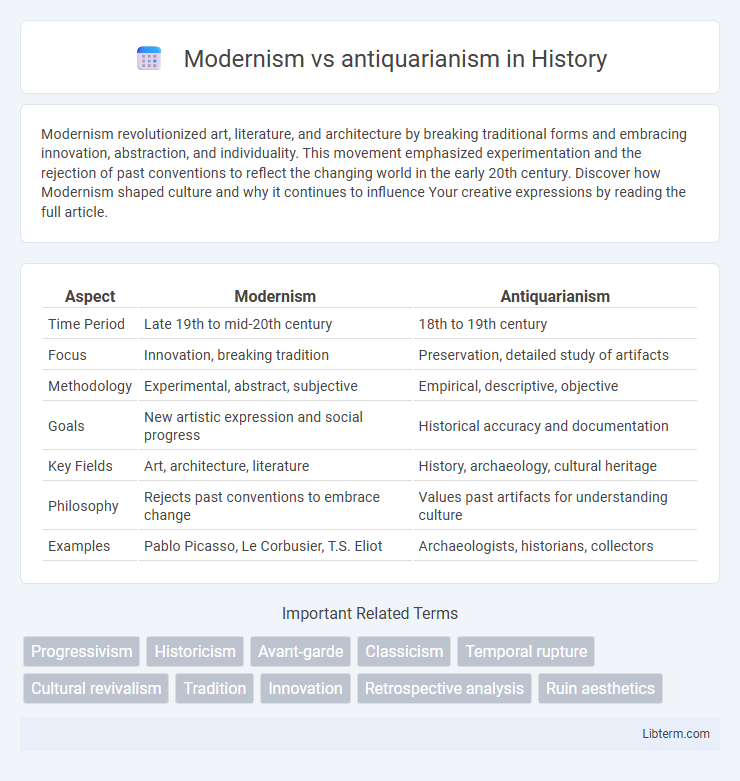Modernism revolutionized art, literature, and architecture by breaking traditional forms and embracing innovation, abstraction, and individuality. This movement emphasized experimentation and the rejection of past conventions to reflect the changing world in the early 20th century. Discover how Modernism shaped culture and why it continues to influence Your creative expressions by reading the full article.
Table of Comparison
| Aspect | Modernism | Antiquarianism |
|---|---|---|
| Time Period | Late 19th to mid-20th century | 18th to 19th century |
| Focus | Innovation, breaking tradition | Preservation, detailed study of artifacts |
| Methodology | Experimental, abstract, subjective | Empirical, descriptive, objective |
| Goals | New artistic expression and social progress | Historical accuracy and documentation |
| Key Fields | Art, architecture, literature | History, archaeology, cultural heritage |
| Philosophy | Rejects past conventions to embrace change | Values past artifacts for understanding culture |
| Examples | Pablo Picasso, Le Corbusier, T.S. Eliot | Archaeologists, historians, collectors |
Defining Modernism and Antiquarianism
Modernism emphasizes innovation, rapid societal change, and the embrace of new ideas and technologies, characterized by a break from traditional forms and conventions. Antiquarianism focuses on the preservation, study, and appreciation of ancient artifacts, customs, and historical records, valuing continuity and historical authenticity. The contrast between these movements lies in Modernism's forward-looking approach versus Antiquarianism's reverence for the past and its material culture.
Historical Origins and Development
Modernism emerged in the late 19th and early 20th centuries as a response to rapid industrialization and social change, emphasizing innovation, abstraction, and a break from traditional forms. Antiquarianism, rooted in the Renaissance and gaining prominence during the Enlightenment, focused on the meticulous study and preservation of historical artifacts and texts, valuing detailed knowledge of the past. The development of Modernism challenged antiquarianism's reverence for history by advocating for new artistic expressions and critical perspectives that redefined cultural narratives.
Philosophical Foundations
Modernism in philosophy emphasizes innovation, progress, and rationalism, rooted in Enlightenment ideals that prioritize human reason and empirical evidence. Antiquarianism, on the other hand, values historical continuity, tradition, and the preservation of past cultural artifacts and knowledge as a foundation for understanding. The philosophical tension between the two lies in Modernism's forward-looking quest for new truths versus Antiquarianism's reverence for historical context and inherited wisdom.
Key Figures and Influencers
Key figures in Modernism include T.S. Eliot, Virginia Woolf, and Pablo Picasso, who revolutionized literature and art with experimental forms and abstract techniques. Influencers of antiquarianism, such as John Aubrey and Sir Richard Colt Hoare, emphasized the preservation and detailed study of historical artifacts and manuscripts. The contrast between these movements highlights Modernism's focus on innovation and progress versus antiquarianism's dedication to historical continuity and preservation.
Artistic and Literary Expressions
Modernism in artistic and literary expressions emphasizes innovation, abstraction, and a break from traditional forms, using fragmented narratives and experimental styles to reflect the complexities of contemporary life. Antiquarianism focuses on the preservation and revival of historical art forms and literary traditions, often prioritizing meticulous attention to detail and authentic representation of past cultures. The tension between Modernism's forward-looking creativity and antiquarianism's reverence for heritage shapes ongoing debates about cultural value and artistic authenticity.
Approaches to Tradition and Progress
Modernism emphasizes innovation and rejects rigid adherence to tradition, advocating for progressive designs that reflect contemporary values and technological advancements. Antiquarianism prioritizes the preservation and meticulous study of historical artifacts and practices, valuing continuity and reverence for established cultural heritage. These opposing approaches highlight the tension between embracing change and maintaining historical authenticity in art, architecture, and cultural expression.
Impact on Society and Culture
Modernism revolutionized society and culture by promoting innovation, individualism, and a break from traditional norms, influencing art, architecture, literature, and social values. Antiquarianism preserved cultural heritage through the meticulous study and collection of historical artifacts, fostering a deep appreciation for historical continuity and identity. The tension between these movements shaped cultural dialogues, balancing progress with preservation in shaping modern societal values.
Case Studies: Iconic Examples
Modernism in architecture is epitomized by the Bauhaus School, which emphasizes functional design, minimal ornamentation, and the integration of technology and industry. In contrast, antiquarianism is exemplified by the restoration of the Palace of Versailles, where preservation of historical authenticity and elaborate decorative elements take precedence. These case studies highlight the tension between innovation in form and function versus the reverence for historical aesthetics and detail.
Criticisms and Controversies
Modernism faces criticism for its perceived rejection of traditional aesthetics, often labeled as elitist or inaccessible by antiquarianism advocates who emphasize historical preservation and cultural continuity. Antiquarianism is contested for its resistance to innovation, accused of romanticizing the past and hindering progress in art and architecture. The debate centers on balancing innovation with respect for heritage, with controversy arising over the valuation of new creative expressions versus the conservation of historical artifacts.
Lasting Legacy and Future Trends
Modernism's lasting legacy lies in its emphasis on innovation, abstraction, and breaking traditional artistic boundaries, influencing diverse fields such as architecture, literature, and visual arts. Antiquarianism, with its focus on preserving historical artifacts and traditions, continues to shape cultural heritage conservation and scholarly research. Future trends suggest a growing integration of modernist creativity with digital technology alongside a sustained commitment to antique preservation through advanced conservation methods.
Modernism Infographic

 libterm.com
libterm.com